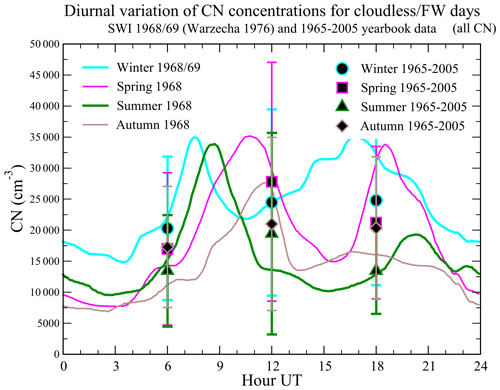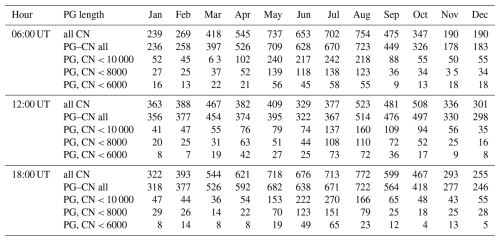the Creative Commons Attribution 4.0 License.
the Creative Commons Attribution 4.0 License.
Diurnal, seasonal, and annual variations of the fair-weather atmospheric potential gradient and effects of reduced number concentration of condensation nuclei on potential gradient and air conductivity from long-term atmospheric electricity measurements at Świder, Poland
Anna Odzimek
Daniel Kȩpski
José Tacza
The atmospheric potential gradient (PG) has been measured at ground level with a radioactive collector method in the Stanisław Kalinowski Geophysical Observatory in Świder (52.12° N, 21.23° E), Poland, for several decades. The long-term Świder measurements analysed previously revealed rather typical behaviour in the diurnal and seasonal variations of the PG of a land station, assumed to be controlled by pollution. Observations of the PG at such a station usually show a maximum at local winter months which are affected by anthropogenic pollution the most. A recently digitised series of 1965–2005 hourly data has been newly analysed to describe the Świder PG variations in greater detail, also in connection with an analysis of simultaneous measurements of condensation nuclei (CN) measured at 06:00, 12:00, and 18:00 UT. An attempt is made to calculate the diurnal and seasonal variations at the CN number concentrations below 10 000 cm−3. There is a decrease in the PG in the diurnal variation by up to 11 % in the winter and no significant change in the summer. The reduction in the annual variation is 11 %–26 %, with the biggest difference in February. In the summer months this difference is negligible. Despite the efforts to minimise the aerosol effect on the PG in the measured CN range, the character of the seasonal and annual variation of PG preserves its character with a maximum in the Northern Hemisphere winter and the minimum in the summer as observed at other mid-latitude stations in this part of the globe. When investigating the effect of reduced CN concentrations on the measured positive conductivity (PC), an increase of 7 %–17 % is found. In addition to an additional mechanism affecting the PG in the summer, there may be another aerosol fraction outside of the range of the condensation nuclei like dust, which affects the conductivity and indirectly the annual variation of the PG.
- Article
(8745 KB) - Full-text XML
-
Supplement
(327 KB) - BibTeX
- EndNote
1.1 Diurnal and seasonal variation of GEC as deduced from the atmospheric electricity station observations
The Global Atmospheric Electric Circuit (GEC) manifests itself in the atmospheric potential gradient (PG) observed at any location on the globe (Rycroft et al., 2000). Diurnal and seasonal variations of the PG are the earliest recognised changes in the PG (e.g. Witkowski, 1902; Israël, 1973b). It has also been previously established that even in fair-weather (FW) conditions the curves of the diurnal variation had different shapes depending on the location of stations, season, and local conditions (Israël, 1973a). At land stations a double oscillation was often observed in the PG variation, present in at least one (usually the warm) season. For example, at Kew, Uppsala, and Tokyo, the diurnal variation of the PG exhibits the double oscillations at any time of the year, while at Helsinki, Tortosa, or Vassijaure it had the double oscillation only in the local summer. At polar stations and over the oceans, a single oscillation is usually observed throughout the year, and its character is unitary in the universal time, which has been firstly recognised by Hoffmann (1924). The average fair-weather variation of the PG calculated from 1920–1925 observations over the oceans on board the Carnegie Institution of Washington research vessel Carnegie is known as the Carnegie curve (Parkinson and Torreson, 1931; Israël, 1973a; Harrison, 2013). This curve is considered to reflect the variation of the diurnal activity of the global circuit and is often compared with the diurnal variation of the PG observed in fair-weather conditions in other places on the globe. In the new century such analyses have been reported by (e.g. Kubicki et al., 2016; Burns et al., 2017; Nicoll et al., 2019; Tacza et al., 2020; Michnowski et al., 2021, and others). In the seasonal or annual variation many observations indicated a winter maximum in the atmospheric potential gradient compared to the summer (e.g. Israël, 1973a; Mani and Huddar, 1972).
Adlerman and Williams (1996) investigated the connection between the PG local winter maximum and the more intensive anthropogenic emission of Aitken nuclei which occurred independent of the station's location in the Northern Hemisphere or Southern Hemisphere. The annual variation of the air conductivity affected by the attachment of ions to aerosol particles, which decreases during the local winter as compared to the local summer, supported this relationship. The question then arises of when the true maximum of the GEC is (Williams, 2009), and Adlerman and Williams (1996) argued this should be investigated based on observations in locations relatively free from aerosol particle effects. Their analysis of Mauna Loa air–Earth current data and reanalysis of the Carnegie and Maud cruises' PG data indicated a GEC maximum in the Northern Hemisphere summer in agreement with the maximum of global thunderstorm activity (e.g. Christian et al., 2003).
In this paper we reanalyse the diurnal, seasonal, and annual variation in the atmospheric potential gradient at the land station Świder (Poland), which also has condensation nuclei monitoring. Previous analyses of the diurnal variation of the PG indicate that Świder is characterised by the double oscillation prevalent in the summer (Northern Hemisphere summer) and the single oscillation in the winter (Kalinowski, 1932). Furthermore, in the annual variation, the PG values in the winter are higher in amplitude (fluctuation level of 30 % of the mean), while the air conductivity variability is higher in the summer (Kubicki et al., 2007). This could be explained by the higher emissions of dust and aerosol affecting the local electric conductivity in the winter (Kubicki et al., 2003, 2007), with the dust having the largest fluctuation over the year of 60 % of the mean and aerosols only 20 % of the their mean. The thermal convection as well as the dependence of dust concentrations on the meteorological conditions is indicated as a significant factor affecting the variations of the PG and conductivity.
Here we particularly analyse these variations at low levels of the nuclei number concentration, which are possible at Świder, in order to investigate whether, with such a limit applied, this may have any considerable indirect effect on the PG through changes in the air conductivity dependent on the concentration of the nuclei. We consider concentrations of the order of several thousand particles, or below 10 000 particles cm−3, which are characteristic of rural, non-urban, and remote regions of the globe (e.g. Landsberg, 1938; Mohnen and Hidy, 2010). For example, Schonland (1953, Table II) cites the results of CN measurements from Heligoland (6300 cm−3) in the conditions of wind from the direction of land. Junge (1951) presents the results of Landsberg (1938) in a different way, with 9500 cm−3 being an average CN concentration for an open country and 5900 cm−3 a mean minimum concentration for a town – these are the conditions we aim to investigate. It is also worth noting the remark by Podzimek et al. (1982) that experiments showed that up to a value of 10 000 particles cm−3 the readings of different particle counters were highly consistent, and the chemical composition of the aerosol became less important for their readings. This further the facilitates comparison of the results obtained in this study with those of other studies conducted under low-particle-concentration conditions, despite different instruments used for the particle count measurements. It is important to note that our maximum CN threshold is 1 order higher than levels found in the cleanest regions of the globe, like the Arctic or the Antarctic, where CN concentrations are often of the order of several hundred in one cubic centimetre, although higher concentrations also occur there (Kubicki et al., 2016; Karasiński and Kubicki, 2024). Therefore, it is expected that we cannot remove completely the influence of anthropogenic pollution in the PG values.
The Stanisław Kalinowski Geophysical Observatory of the Institute of Geophysics, Polish Academy of Sciences, was founded as the Magnetic Observatory, and in 1929 it was renamed to the Geophysical Observatory, though it also worked as an atmospheric electricity station, except during World War II until 1947. Most of the pre-war electric measurements were lost, and publication of new results of the resumed electric measurements started in 1958. Measurement reports from the years 1957–2005 were subsequently published on paper in the form of yearbooks with tabulated data. The first and last paper issues were Warzecha (1960) and Kubicki (2006). The list of all yearbooks providing data for this study can be found in the Supplement. Since the beginning of the atmospheric electric measurements at Świder, the PG and conductivity were the main variables to be measured; however, only PG measurements were started initially in 1929. After 1949 the observations were complemented by measurements of the air conductivity. Initially these measurements were conducted 3 times a day (see Sect. 2.3); both polarities were measured and reported in the yearbooks until 1964. In 1965 measurements of the air positive conductivity (PC) were given a priority, and its hourly values have been reported in the yearbooks continuously since then (Warzecha, 1968), although the negative conductivity measurements have not been withdrawn, and some unpublished regular paper records from the period still exist in the archives of the observatory (Marek Kubicki, personal communication, 2024). In this paper we aimed at analysing the PG and PC, as well as some of the effects CN have on them, with emphasis on PG since it is the most commonly measured parameter of atmospheric electricity worldwide. In the final sections we also consider shorter data sets for which both positive and negative conductivity records are available.
2.1 Site location
Świder is located in the central part of Poland in the Warsaw suburban area, about 25 km south-east of Warsaw (52.12° N, 21.23° E). It used to be a popular holiday and health resort village located on the Świder river. The distance to the nearest urban centre, which is the district town of Otwock, is 2.5 km. There is no major industry in the area, but there are local anthropogenic sources of air pollution from household heating – very typical for these suburban conditions. The architecture is dominated by residential buildings and mainly includes single-family and multifamily houses. The observatory is located in a less populated area near the river. It includes the main office and three observation pavilions, as well as two residential buildings at a distance. The entire area covers about 7 ha and is partly covered and predominantly surrounded by pine trees, with several clearings. In one of these clearings of an area of approximately 1 ha, one pavilion and the station's instruments for atmospheric electricity and meteorology observations are located.
2.2 Potential gradient and conductivity data
The measurements of the fair-weather atmospheric potential gradient at the Świder observatory have been made with radioactive collectors (with a radioactivity of about 30 µCi). Initially two independent collectors were used, each consisting of the radioactive sonde at a height of about 2 m connected to an electrometer and a recording milliammeter. At the beginning, Benndorf electrometers were used, and in 1964 they were replaced by observatory-built electrometers (Warzecha, 1968, 1976). After 2000 they were replaced by commercially available electrometers. The recording milliammeter was also later replaced by an A/D logger. The PG measurements have absolute calibration and reduction to free plane values (e.g. Kubicki, 2006, and earlier yearbooks). The PG was reported as the atmospheric electric field strength, in agreement with the atmospheric electricity convention of its sign (positive value indicates downward direction of the vector). The air conductivities due to small ions have been measured using a Gerdien tube apparatus, replaced in 1965 with observatory-built aspiration condensers, at 1.4 m height. Hourly averages for each month of the PG measured with the collector as well as the positive conductivity, PC, were calculated, and the tabulated data were published in the yearbooks.
2.3 Condensation nuclei data
After continuous atmospheric electricity observations were resumed after the war, simultaneous regular measurements of aerosol particle number concentrations of the condensation nuclei type (CN, particle size from 0.005 to 10 µm) were also started (Warzecha, 1960, 1974).
These measurements were carried out using two types of counters: initially using a small Scholz counter and from 1982 with a photoelectric CN counter built in the observatory which used a chamber of a Verzár counter as a base (the Verzár counter was previously used for occasional continuous observations). The Scholz and Verzár counters are described in more detail by Grabovskiy (1956). The measurement method used by these counters is the process of condensation of water vapour on atmospheric aerosol particles present in the measurement chamber, followed by a quantitative analysis of the resulting mist droplets. A Scholz counter is a type of condensation counter constructed by Scholz as an improvement of the Aitken counter, designed to measure the total concentration of condensation nuclei or nearly the total concentration of aerosol. The main part of the small Scholz counter was a brass cylindrical chamber with a volume of 102 cm3 and a height of 4 cm; the adiabatic volume expansion ratio was 1.25 (rather than the usual standard of 1.2; Grabovskiy, 1956). According to Miller and Bodhaine (1982), at such an expansion ratio the supersaturation is in the range 2.93–3.40 for initial temperatures between 25 and 10 °C, respectively, which is equivalent to the supersaturation between 3.93–4.40 according to Wilson (1897). The Scholz counter allows measurements in a wide range of CN concentrations from 5 to 960 000 particles cm−3, and its experimental error should not be higher than the experimental error of the Aitken counter, which is about 10 % (Grabovskiy, 1956; McMurry, 2000). Measurements with the Scholz counter were repeated 5 times, and one measurement could take several minutes. At Świder they were performed using the suction method of an air sample of 1 cm3 in volume taken within the clearing near a meteorological station.
Since January 1983, the measurements have been performed with the photoelectric CN counter that was placed inside a measurement pavilion. The basic measurement of the number of CN took place in a cylindrical chamber filled with the tested air sample of the volume equal to 680 cm3. Estimates of the number of droplets were obtained using a photoelectric counter system by measuring the extinction of light. The air samples were collected from the outside of the building at a height of 1 m above the ground. The suction of air was made through a 1 m long rubber pipe using an electric rotational pump. The measuring range of the counter was 4500 to 850 000 CN in 1 cm3. The electronic circuit system was built (also patented) by Stanisław Warzecha. The measurement accuracy was 15 % (Warzecha and Warzechowa, 1979). The yearbooks or other published reports known do not provide any details on the cross-check of measurements during the instrument transition period.
The measurements were made at a height of 1 m, except in 1998–1999 at 3 m. Observations were performed 3 times a day: first between 06:10 and 06:30 UT (5:50–6:20 UT until 1971), next between 11:00 and 11:30 UT, and last between 18:10 and 18:30 UT (19:00–19:30 UT until 1971). The average results of the measurements at the three terms referred to in the yearbooks as 06:00, 12:00, and 18:00 UT, respectively, have been included in the observatory yearbooks.
2.4 Criteria of fair-weather conditions
In order to investigate global signals of atmospheric electricity and minimise the effects of local weather, criteria for fair-weather conditions are used (e.g. Imyanitov and Chubarina, 1967). Since 1965 a WMO standard for the fair-weather conditions has been applied at Świder: low cloudiness up to in okta scale, no precipitation or fog, wind speed less than 6 m s−1 and PG amplitude less than 1000 V m−1, and no negative PG values (e.g. Warzecha, 1968; Kubicki, 2006). The criteria for fair-weather conditions were assessed by the observatory staff on an ongoing basis. Foul- and fair-weather hours are marked in the yearbooks' PG or PC monthly tables.
In our analysis we consider all fair-weather hourly values of the potential gradient (PG) and the condensation nuclei (CN) concentrations from 06:00, 12:00, and 18:00 UT published in the observatory yearbooks of 1965–2005 (no criterion regarding the minimum number of points in a month has been applied). There is a total of 131 634 hourly PG values with a subset of 16 072 hourly values with corresponding CN concentrations and 3303 missing data points (2.5 %). Table A1 and Table A2 in the Appendix A include the number of FW hourly average mean values of PG and the number of FW days (24 h) for each month and year of the analysed period. There are more FW values during the local warmer seasons from March to September. The percentage of FW hours is about 37 % on average (see also Table 1) and varies between 49 % in the summer and 23 % during winter. The total number of FW days is 1414. The monthly percentage of FW days is about 9 % on average, rises to 14 % during summer, and decreases to 4 % during winter.
Table 1Number of total hours for the period of January 1965–December 2005, number of all fair-weather (FW) hours, FW hours with a PG value, and number of the hours or PG values corresponding to all CN observations and to the CN concentrations below 10 000, 8000, 6000, and 4000 cm−3, respectively. The percentages in columns refer to the number in bold in the first row of the table according to the position of the percentage in the column.

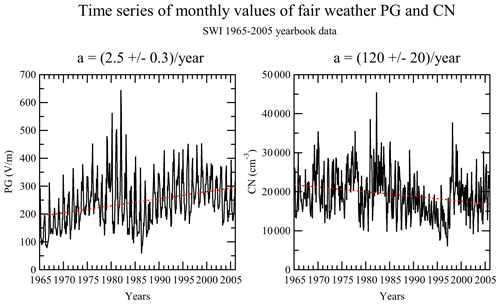
Figure 1Time series of monthly averaged values of fair-weather PG and CN values over January 1965–December 2005. The dashed red lines indicate a positive trend for PG (2.5 ± 0.3 ) and a negative trend for CN (−120 ± 20 cm−3).
The time variations of monthly mean values of PG and CN during this period are shown in Fig. 1. There seems to be several periods of monotonic increase and decrease in the PG and a general trend of increase in the PG by 2.5 . The general trend for CN concentration is a decrease by −120 ± 20 . Analysis of the long-term variation in these series will be a subject of another study.
Table 2Statistical measures of the distribution of all values' FW PG and CN in the series 1965–2005.

A histogram of these values and the main statistical parameters of the set are given in Fig. 2 and in the last column of Fig. 2. The mean average, Ma, of the total fair-weather PG of 1965–2005 is 231 V m−1, and the standard deviation, SD, is 131 V m−1. The median, Me, is 207 V m−1; the first quartile, Q1, equals 139 V m−1; and the third quartile, Q3, 294 V m−1. The kurtosis, K, equals 5.4, and the skewness, S, is 1.3, which characterises a leptokurtic and right-skewed distribution. These parameters describe the total FW PG set, but in the next sections we concentrate on the subset of PG hours for which simultaneously measured CN data also exist and particularly on the subset for limited CN concentrations less than 10 000 cm−3. The statistical parameters of the distribution of these subsets are also given in Fig. 2. The selection of PG data measured at the same time as CN creates a new distribution with a slightly higher mean (249 V m−1) or median (224 V m−1) value but similar kurtosis and skewness of ∼ 5.5 and ∼ 1.2, respectively. When we further limit the CN concentrations to less than 10 000 cm−3, the mean and median value are lower, 221 and 208 V m−1, respectively. It also affects the kurtosis, which in this case equals 4.7, and skewness, which is 1.0. Selection of PG–CN pairs limits the number of values, N, to 16 074 (12.21 %), and with the condition of CN lower than 10 000 cm−3 the number of pairs decreases to 3593 (2.72 %) as indicated in Table 1.
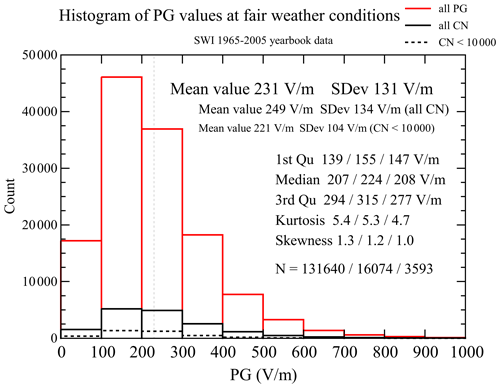
Figure 2Histogram of the PG values measured during fair-weather conditions in January 1965–December 2005: red colour – all PG values; black colour – PG values recorded simultaneously with CN concentrations; black dashed line – the PG values at CN concentrations below 10 000 cm−3. The vertical grey dashed line represents the mean PG value (230 V m−1). The other statistical parameters separately for the three PG groups are given in the legend, including the number of data values, N.
In Fig. 3 we show a histogram of CN concentrations in fair-weather conditions. The mean value of all FW CN concentrations is 18 970 cm−3, and the standard deviation is 13 270 cm−3, but there are almost twice as many counts in the summer compared to winter. The median is 15 400 cm−3, the first quartile is 10 290 cm−3, and the third quartile is 22 650 cm−3. The kurtosis is equal to 8.8, and the skewness is 2.1, which indicates a leptokurtic and right-skewed distribution. The total number of the FW values is 16 756, and the counts for the subset below 10 000 cm−3 (see black frame in Fig. 3) equal 3736, which corresponds to 22 % of the total. Table 2 and Fig. 4 show the main statistical measures of the FW PG and CN distributions discussed above and separately for each season. The black line separates the distributions of CN concentrations below 10 000 cm−3.
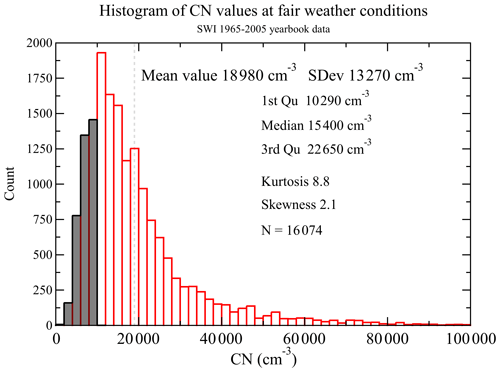
Figure 3Histogram of hourly averaged CN concentrations at fair-weather conditions in January 1965–December 2005: CN below 10 000 cm−3 are framed in black; red colour – all CN. The vertical grey dashed line represents the mean CN concentration value of 18 980 cm−3.
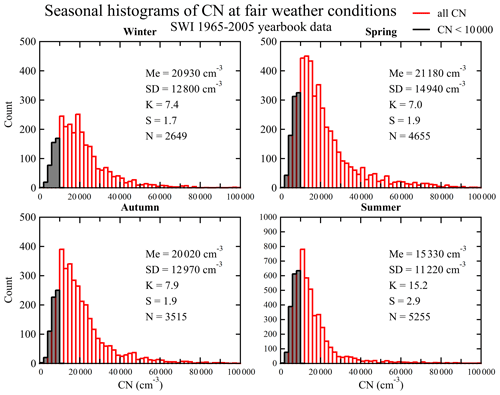
Figure 4Seasonal histograms of the hourly averaged (06:00, 12:00, and 18:00 UT) CN concentration values measured during fair-weather conditions for the period of January 1965–December 2005: red colour – all CN concentration values; black colour – CN concentration values below 10 000 cm−3. Note that the y-axis ranges for summer (0–1000 counts) are twice as large compared with the other seasons (0–500 counts).
The lowest concentrations of CN in fair-weather conditions (the minimum is 1400 cm−3) are observed in the summer, with the mean value of ∼ 15 000 cm−3. In the other seasons the mean value is close to 20 000 cm−3, with the highest standard deviation values ∼ 15 000 cm−3 in the spring and the lowest ∼ 11 000 cm−3 in the summer, as well as ∼ 13 000 cm−3 in the winter and in the autumn. In terms of kurtosis and skewness, the values in the spring, autumn, and winter are similar and vary between 7.0–7.9 and 1.7–1.9, respectively. In the spring these parameters are higher, reaching values 15.2 and 2.9.
In this section we analyse the diurnal and seasonal variation of Świder FW PG and how it relates to different levels of CN concentrations. Previous works on the analysis of diurnal and seasonal variations of PG focused mainly on a full 24 h period of FW, i.e. an FW day needed to accomplish FW conditions for each hour between 00:00 and 23:00 UT (Kubicki et al., 2016). This restriction limited the amount of available data. Michnowski et al. (2021) used FW PG values with at least 12 h of fair-weather conditions. In this work we increase the amount of data by taking into account every FW hourly value to calculate the diurnal and seasonal variations.
4.1 Diurnal variation of PG
Figure 5 presents the PG diurnal variation by season (winter – December, January, February; spring – March, April, May; summer – June, July, August; autumn – September, October, November) and the all-year mean variation. The shape of the PG curve is substantially different depending on the season. During the winter months there is a single broad maximum lasting from noon (∼ 13:00 UT) until the late evening (∼ 20:00 UT), whereas during the spring–summer–autumn period double maxima (∼ 07:00 and ∼ 19:00 UT) are present. The amplitude variation of the PG curve during the winter is larger than in the summer (Table 2). Świder is thus characterised by the type I of the “double oscillation” variation in the diurnal average curve according to Israël (1973a); i.e. the double oscillation is prevalent except in local wintertime, and its maxima occur at different hours depending on the season. Differences between the PG diurnal curves at Świder and the classical Carnegie diurnal curve come from the much greater variability and dynamics of the planetary boundary layer (PBL) characteristic of the location, and at Świder they are affected by pollution, meteorological factors, and seasonal effects (Kubicki et al., 2016; Nicoll et al., 2019; Michnowski et al., 2021, Sect. 4).
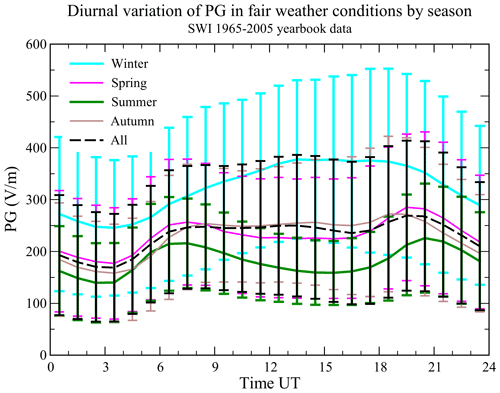
Figure 5Diurnal variation of PG measured during fair-weather conditions by seasons and for the whole year in January 1965–December 2005. The error bars represent ± 1 standard deviation.
Since we cannot calculate the whole diurnal variation of CN concentration, we show results only for 06:00, 12:00, and 18:00 UT (represented by symbols) in Fig. 6. The Świder 1968/69 diurnal curves from Warzecha (1976) obtained by the recordings with the Verzár counter every 15 min are shown in the background (solid lines). We note that in this comparison we calculated the mean values only for 24 h FW days since Warzecha (1976) presented the diurnal curves for cloudless days. The highest mean CN concentrations at these hours are registered at 12:00 UT, although looking at diurnal curves of Warzecha (1976) this is already after the morning maximum of CN concentrations between 06:00 and 12:00 UT (all seasons) and before the afternoon/evening maximum. These values are especially high in the winter and the spring. The concentration values at 06:00 and 18:00 UT are similar; however, the lowest values are noted in the morning. At 06:00 and 18:00 UT the mean CN concentrations in the spring and autumn are almost equal, while at 12:00 UT the spring mean is higher, even than the winter value, which generally is the highest among seasons. Compared with the diurnal curves of Warzecha (1976) the CN concentrations fairly agree with the diurnal variation except for 18:00 UT (excluding summer) and 12:00 UT in summer and autumn. Some differences are likely since we compare long-term mean values with 1-year means. Nevertheless, it is worth noting that the diurnal CN curves fall between the CN averages at 1 standard deviation.
4.2 Seasonal and annual variation of PG
Similarly to Fig. 4, in Fig. 7 we show the seasonal differences in the distribution of FW PG at different CN concentrations. Their main statistical parameters for seasonal distributions are given in the figures as well as in Table 2. Figure 7 presents the seasonal histograms of the hourly averaged (at 06:00, 12:00, and 18:00 UT) FW PG values for 1965–2005. Each histogram contains two types of distributions: red colour indicates the FW PG values measured simultaneously with CN concentrations and green regions with black contour indicate a subset of the FW PG values for CN concentrations less than 10 000 cm−3. The main statistical measures for both of these distributions are displayed within each plot. Depending on the season we observe different PG distribution characteristics. For spring, summer, and autumn most values ranged between 100–300 V m−1, with a mean value of ∼ 250 V m−1 in the spring and autumn and ∼ 200 V m−1 in the summer. Winter values ranged between 200–400 V m−1, and the mean was ∼ 350 V m−1. The standard deviation is also the highest in the winter. The kurtosis values for the spring and autumn are 4.7–4.8, while the summer kurtosis is the highest at 5.7 and the winter is the lowest at 3.2. The skewness of the winter distribution is the lowest at 0.6, and the skewness of all the other distributions is between 0.8–1.2, indicating more values concentrated around the mean value. We have used the non-parametric Kolmogorov–Smirnov (KS) test and the Mann–Whitney U (MW) test to estimate the statistical significance of the difference between the PG distributions for decreasing CN concentrations. In regard to the distributions shown in Figs. 2 and 7, both KS and MW tests indicated statistically significant differences (at the significance level of 0.05) between the PG–CN all (all CN concentrations) and PG–CN < 10 000 distributions for the whole year as well as in the spring, autumn, and winter. In the case of the variations shown in Fig. 11, the KS test indicated statistically significant differences between the PG populations for all CN and CN < 10 000 in January and February only. The MW test indicated this in April and November as well. When comparing PG and CN all with PG and CN < 8000, the results of both tests indicate the statistically significant difference also in December, similarly to PG and CN < 6000.
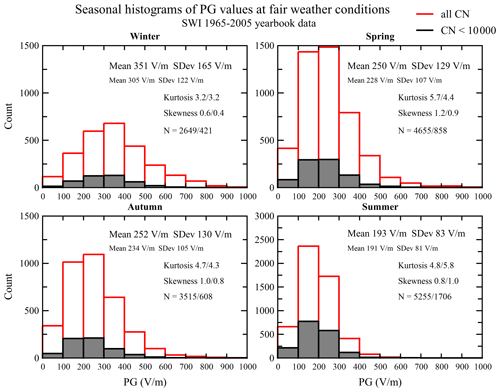
Figure 7Seasonal histograms of the hourly averaged (06:00, 12:00, and 18:00 UT) PG values measured during fair-weather conditions in January 1965–December 2005: red colour – PG values measured simultaneously with all CN concentration values (06:00, 12:00, and 18:00 UT); black colour – PG values measured simultaneously with CN concentrations below 10 000 cm−3. Note that the y-axis ranges for summer (0–3000 counts) are twice as large compared with the other seasons (0–1500 counts).
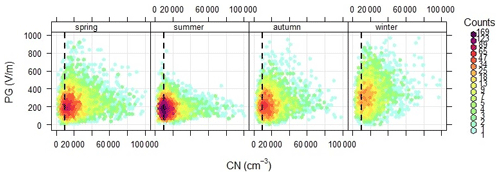
Figure 8Seasonal dependence of hourly averaged values of fair-weather PG and CN concentration values in January 1965–December 2005. Horizontal dashed lines indicate the limit of CN concentration at 10 000 cm−3.
Another way to look at the relationship between aerosol and condensation nuclei concentration is presented in Fig. 8. The colour intensity indicates the number (counts) of data points at a certain range of PG and CN. Here the PG values are plotted against CN concentrations by season. In the summer there seems to be little influence of CN concentration on PG as the similar range of PG values is observed at wide range of CN concentrations. Some kind of dependency is visible in the winter, and spring and autumn are intermediate in this sense, with some high PG values at high CN concentrations.
When the continuity of the conduction current is fulfilled, the atmospheric potential gradient depends on the local conductivity of the air. The process of attaching small ions to aerosol particles causes a reduction in the ion concentration (loss of small ions) and a change in their mobility as large ions and, consequently, a decrease in the electrical conductivity and an increase in the PG values (e.g. Israël, 1973a; Bennett and Harrison, 2008; Matthews et al., 2019; Wright et al., 2020). In this section we analyse if limiting CN concentrations to the possible lowest ranges in the CN distribution affects the PG values and their variations. Firstly, we consider CN concentrations below 10 000 cm−3 (black-green histograms in Fig. 4), next we decrease the concentration limit by 2000 to 8000 cm−3, and then we decrease the concentration limit to 6000 cm−3 to investigate the diurnal, seasonal, and annual variations of PG at these lowest CN concentrations occurring at Świder. In earlier sections we showed that limiting the CN concentration to 10 000 cm−3 did not significantly change the kurtosis and skewness of the PG distributions; however, their average mean values differ (see also Sect. 7), and here we investigate if any possible extreme CN limits affect variations of the PG in this representation. The right part of Table 1 presents the counts and percentages of the whole fair-weather PG population of values within each CN concentration limit. In Fig. 9, in the upper panel we show the histograms of CN concentrations, and in the lower panels we show the histograms of PG values at the three selected limits of CN concentration. There are 3736 values below 10 000 cm−3, 2086 values below 8000 cm−3, and 939 values below 6000 cm−3, which is about 23 %, 13 %, and 6 % of all CN concentrations, respectively. Below 4000 cm−3 there were only 123 values (0.8 %), and therefore this subset was not taken into account. These values represent the whole span of the studied time period, as shown in the panel inset in the top panel of Fig. 9. They also represent all seasons as shown in Table 7, even though there are proportionally more counts in the warmer season because of more frequent FW conditions. In the lower panels of Fig. 9, the histograms of corresponding PG values are shown. We note a slightly decreasing tendency in the mean value of the population, especially at CN concentrations below 6000 cm−3, of approximately 210 V m−1, as well as lower kurtosis and skewness compared with the distributions below 10 000 and 8000 cm−3.
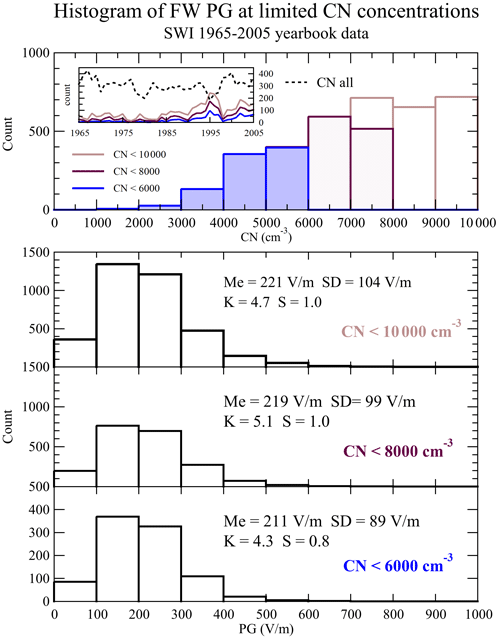
Figure 9Histograms of the limited CN concentration values measured during fair-weather conditions divided into CN range: below 10 000 cm−3 (brown), 8000 cm−3 (maroon), and 6000 cm−3 (blue). Bottom panels: histograms of hourly averaged PG values measured at limited CN concentration.
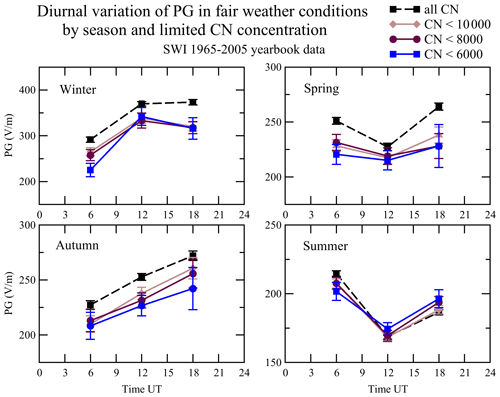
Figure 10Diurnal variation of PG values measured during fair-weather conditions at 06:00, 12:00, and 18:00 UT divided into seasons for the period of January 1965–December 2005 for all CN concentration values (black) and CN concentration values below 10 000, 8000, and 6000 cm−3. Error bars indicate 1 standard error of the mean.
Table 3Mean values of the fair-weather PG by season for all and limited CN concentration values together with 1 standard error of the mean corresponding to 06:00, 12:00, and 18:00 UT and on average.
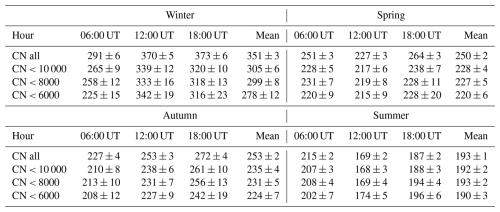
Seasonal means are shown in Table 3 and Fig. 10 for each hour term (06:00, 12:00, and 18:00 UT) and the mean average over the terms, together with the standard error of the mean. Here we also notice a decrease in the mean values of PG for each term at lower CN concentrations, particularly at the 6000 cm−3 limit (i.e. comparing PG values between CN all and CN below 6000 cm−3). This is present in the winter (73 ± 15 V m−1 or ∼ 13 % for total mean value), spring (30 ± 8 V m−1 or ∼ 12 %), and autumn (29 ± 9 V m−1 or ∼ 12 %), and the decreases are larger for 06:00 UT (e.g. 30 ± 12 V m−1 or 12 % in the spring) and 18:00 UT (e.g. 57 ± 29 V m−1 or 15 % in the winter, 36 ± 23 V m−1 or 14 % in the spring). However, in the summer there is practically no effect of CN and no clear tendency of decrease or increase (with the largest decrease being several V m−1 only).
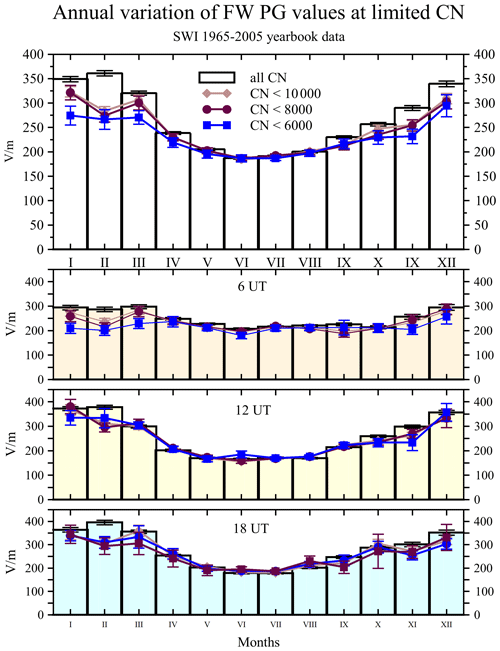
Figure 11Annual variation of potential gradient in fair-weather conditions for all and limited CN concentration values for all hours (upper chart) and separately for each hour (06:00, 12:00, and 18:00 UT). Error bars indicate 1 standard error of the mean.
Table 4Mean values of PG in fair-weather conditions by month for all and limited CN concentration values together with the standard error of the mean value corresponding to 06:00, 12:00, and 18:00 UT.
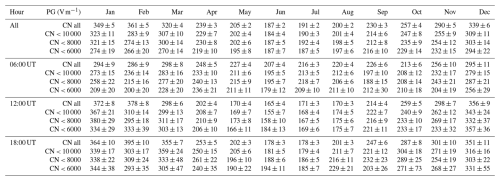
Finally, in Fig. 11 and Table 4 the annual variation of FW PG is presented, calculated as monthly averages. Additionally in Table A3 in the Appendix A the number of FW PG values calculated as monthly values for all and limited CN concentration is presented. PG variations calculated at 06:00, 12:00, and 18:00 UT are plotted separately from the average curve. The maximum of the PG is in February, which is also the maximum at 12:00 and 18:00 UT. The minimum of the PG is in June, which is also the month of the minimum at 06:00, 12:00, and 18:00 UT. The lowest PG amplitudes of the differences between the maximum and the minimum are seen in the 06:00 UT curve, 91 ± 12 V m−1 (wide maximum from December–March, minimum in June), and much higher PG differences are seen in the 12:00 and 18:00 UT curves, 213 ± 12 V m−1 (February–June) and 217 ± 13 V m−1 (February–June/July), respectively, with 174 ± 7 V m−1 (February–June) in the average curve.
In the PG variations represented by the curves calculated with limitations of CN concentration, there is a significant reduction of PG from October to March (11 %–26 %), and the biggest differences are seen in February at each term: 06:00, 12:00, and 18:00 UT and on average. In February the PG decreases by 95 ± 25 V m−1 or 26 %. In January and November the change is about 20 % (75 ± 24 V m−1 and 58 ± 20 V m−1, respectively), and in December it is about 13 % (45 ± 28 V m−1). From April to September there is a lack of or little influence of low CN concentration, and the PG differences are mostly of several V m−1, which is of the order of the standard deviation of the mean error, except for April and September, where these differences can be larger than 10 V m−1. In September at 18:00 UT we note a larger decrease in PG of 44 ± 29 V m−1 (18 %). In addition, as we already have seen in the seasonal plots in Fig. 10 at 12:00 UT there is even an inverse relationship between the PG and CN, for example, in July at 12:00 and 18:00 UT and in August at 18:00 UT, although most of these differences are within the statistical error. In terms of the change in the amplitude of maximum–minimum differences at 06:00 UT, there is a small change with decreasing CN concentration reaching 77 ± 41 V m−1 (December–June) at the 6000 cm−3 CN limit. At 12:00 UT it is 165 ± 35 V m−1 (January–July) at the 6000 CN limit, while at the 10 000 and 8000 CN limit it is practically the same as with no limits (∼ 213 ± 12 V m−1, January/February–June–July). At 18:00 UT at all CN limits the amplitude is ∼ 160 V m−1 compared with 217 ± 13 V m−1 with no limits. There seems to be a slight shift between the maximum and minimum month, which is January or February for the maximum and June or July for the minimum. In general, there are significantly lower differences between winter and summer in the annual variation of the FW PG at the lowest CN concentration limit considered; however, the maximum still stays in the winter (December–January–February).
Table 5Model of ion conductivity with CN concentrations dominated by soot: concentrations of the CN components, the ion–aerosol loss term βN, ion conductivity, and conductivity ratios at different concentration ratios of water-soluble particles and soot components. A constant concentration of insoluble aerosol at 500 cm−3 is added to the total CN concentration.
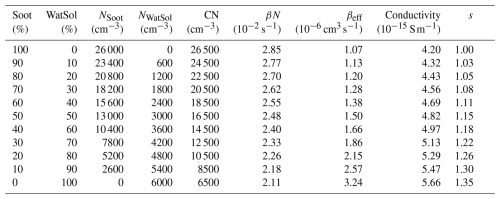
In this section we model a hypothetical change in the PG when we limit the number concentration of CN. The relationship between atmospheric electric potential gradient and aerosol concentration is complex. These two most often measured variables are related through the electrical conductivity of the air. The conductivity, σ, is influenced by the loss of small atmospheric ions due to attachment to aerosol particles, and it decreases when the attachment intensifies. When we assume that the mobility and concentration of positive and negative ions are equal and the ions are singly charged, then in a steady state the ion conductivity is determined by Eq. (1) (e.g. Schonland, 1953; Makino and Ogawa, 1985; Sapkota and Varshneya, 1990):
where e = 1.6 × 10−19 C is the elementary electric charge, μ is the ion mobility, n is the ion concentration, q is the ion production, α is the ion recombination rate coefficient, βN represents the ion loss due to attachment to particles and droplets of concentration N, and β is the attachment rate coefficient. In the atmosphere the loss of ions in fair weather is mainly due to the attachment to aerosol particles. The process of attachment is dependent on both the number concentration and the spectrum of the size of aerosol particles and is usually expressed by the ion–aerosol loss term, in general being a sum of contributions over different aerosol types and sizes (e.g. Israël, 1973a; Tinsley and Zhou, 2006). The term can be replaced by the effective coefficient β and the total aerosol concentration N, i.e. βN as in Eq. (1). We set the other parameters in Eq. (1) as follows: q = 2.2 cm3 s−1, α = 1.3 × 10−6 cm−3, and μ = 1.5 cm2 (V s)−1, similarly to other conductivity models based on other empirical models and measurements (Makino and Ogawa, 1985; Sapkota and Varshneya, 1990; Tinsley and Zhou, 2006; Kulkarni, 2022). The ion production by cosmic rays of the order of 1.0 is appropriate for the production at the ground level, and that of the order of 1.0 is appropriate for the production by the radioactivity of radon. We set the total ion production value at Świder to 2.2 . The mobility of 1.5 ± 0.3 up to 15 km could be used for both positive and negative ions according to (Swider, 1988).
In cases where the conduction current, jC = σ PG, is preserved, a decrease or increase in the electrical conductivity should result in a proportional increase or decrease in the potential gradient:
where indices 1 and 2 refer to value before and after the change, respectively.
Rural continental aerosols of natural origin occur in Świder, but there may be a lot of pollution from suburban traffic and domestic heating (Majewski and Przewoźniczuk, 2009; Pietruczuk and Jarosławski, 2013). More recent observations to the considered CN concentration measurements at Świder of aerosol size distribution confirm the occurrence of polluted aerosol, which consists of large concentrations of fine particles dominated by the nuclei mode of the mean diameter of 20–30 nm and by the accumulated mode of the mean diameter of 100–120 nm (Kubicki et al., 2016). We focus on the winter conditions when the decrease in the potential gradient at lower CN concentrations, expected to be due to the decreasing effect of pollution on the air conductivity, is the biggest as obtained in Sect. 4, and then we estimate the effect during the summer. We emulate the conditions by calculating the conductivity at different aerosol composition and concentrations. Let us consider a mix of continental aerosol types that the Świder aerosol may be composed of and calculate the corresponding conductivities as well as the ratio of the conductivities as in Eq. (2).
According to Hess et al. (1998), land aerosol may consist of three to four main aerosol types: continental clean, continental average, continental polluted, and urban. These aerosol types consist of three basic aerosol components: water insoluble (WatInsol), water soluble (WatSol), and soot (Soot), with the last two contributing almost 99 % of the total concentration and contained in the range of CN particle size. Their individual β coefficients are βWatInsol = 2.80 × 10−5 cm3 s−1, βWatSol = 1.18 × 10−6 cm3 s−1, and βSoot = 5.56 × 10−7 cm3 s−1, respectively, obtained from calculations based on the equations used in Tinsley and Zhou (2006). In this model the effect of relative humidity on the conductivity is not included.
where NWatInsol, NWatSol, and NSoot are the number concentrations of the three aerosol components.
Table 6Model of ion conductivity with CN concentrations dominated by water-soluble particles: concentrations of the CN components, the ion–aerosol loss term βN, ion conductivity, and conductivity ratios at different concentration ratios of water-soluble particles and soot components. A constant concentration of insoluble aerosol at 200 cm−3 is added to the total CN concentration.
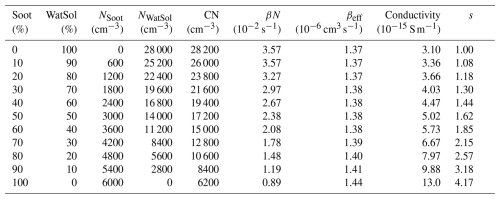
At first we set the limiting values of concentration N for 100 % relative composition of soot versus 100 % water-soluble aerosol at 26 000 cm−3 (NSoot) and 6000 cm−3 (NWatSol), respectively. The first value corresponds to the highest average aerosol concentrations in the winter (Fig. 4, Table 2), and the second value refers to the lowest concentrations measured at Świder (∼ 4000 values occur too, but they are very rare). A small, constant contribution of insoluble aerosol of 500 cm−3 is also assumed. In Table 5 we present the results of the model calculations when the relative proportions of water-soluble and soot components vary (columns 1–2), but the total concentration is dominated by the soot component, except at the lowest ratios of , which result in water-soluble aerosol at a low number concentration. Columns 3–5 give the resulting number concentrations of NSoot and NWatSol, as well as the total CN concentration. In column 6 we give the calculated ion–aerosol loss term βN, and in column 7 we give the effective ion attachment rate , which here varies from 1.07 to 3.24 × 10−6 cm3 s−1. Sapkota and Varshneya (1990) mention that Hoppel predicts a range of 0.8 to 3.0 × 10−6 of βeff for the continental aerosol. In the last column we give the calculated conductivity. The conductivities calculated from the digitised 1965–2005 data are 4.4 ± 0.2 × 10−15 S m−1 for the winter and 8.0 ± 0.2 × 10−15 S m−1 for the summer. The values given equal twice the seasonal average of the positive polar conductivity calculated from the hourly values reported in the observatory yearbooks (in fair-weather conditions).
An average winter situation may correspond to the concentrations of 1200 cm−3 of water-soluble aerosol and 18 200 cm−3 of soot, which give the total CN concentration of 20 500 cm−3, since the average observed mean is ∼ 20 900 cm−3. For the observed median, ∼ 18 200 cm−3, 1800 cm−3 of water-soluble aerosol and 15 600 cm−3 of soot could be more appropriate. The conductivity values in these cases, 4.56 and 4.69 × 10−15 S m−1, are close to 4.4 × 10−15 S, an average observational winter value. This has been adjusted by assuming q = 2.2 cm3 s−1. When we look for concentrations characteristic of the summer, this would rather be reflected by 4200 cm−3 of water-soluble aerosol and 7800 cm−3 of soot for the summer average mean ∼ 15 300 cm−3, as well as the median ∼ 12 300 cm−3 (Fig. 4, Table 2). However, the conductivity for such concentration is 4.97 × 10−15 S m−1 and remains much too low compared with the observations, since the summer average is ∼ 8.0 × 10−15 S m−1. Such conductivity level requires the ion–aerosol loss term βN be about 1.5 × 10−2 s−1 and the effective βeff = 1.25 × 10−6 at N = 12 000 cm−3 or βeff = 1.0 × 10−6 at N = 15 000 cm−3. Such values of β are more of the order of βWatSol; therefore, we now consider a mix of the three selected aerosol components dominated by the water-soluble component. We set the limiting values of concentration N for 100 % relative composition of soot versus 100 % water-soluble aerosol at 6000 cm−3 (NSoot) and 28 000 cm−3 (NWatSol), respectively. Now the lowest concentrations are only due to soot and small additions of water-soluble concentrations. A small, constant contribution of insoluble aerosol of 200 cm−3 is assumed in this case. The results of the conductivity calculations are shown in Table 6.
An average summer situation may correspond to the concentration ratio of 40 % vs. 60 % of the water-soluble and soot components, which give the total CN concentration of 15 000 cm−3. The conductivity in this case is 5.73 × 10−15 S m−1. When we look for concentrations characteristic of the winter, they would rather be reflected by the ratio of 70 % vs. 30 %, i.e. CN total 21 600 cm−3, and the model conductivity is close to the observational value of ∼ 4.4 × 10−15 S m−1. It seems this conductivity model could describe both winter and summer conditions; however, situations from the model of Table 5 cannot be excluded.
Table 7Mean values of the fair-weather positive conductivity (PC) by season for all and limited CN concentration values together with 1 standard error of the mean.

There may be other atmospheric particles that cause a larger difference between the winter and summer conductivities, like the dust particles, even though these are in general much less numerous than CN. The conductivity value very much depends on both βeffN and q, with βeffN depending on the distribution of the sizes of the aerosol particles. In particular, the insoluble component also plays an important part through the high attachment rate. These may also vary between the summer and the winter. More analysis and observational data from Świder are needed to develop a more realistic conductivity model, particularly of the aerosol size distributions.
In this section we analyse the annual variation of the fair-weather positive conductivity (PC or λ+) and the effect of decreased CN concentrations, similarly as in Sect. 5. The total number of FW PC hourly values is lower than the total number of FW PG: 124 213 hourly values (about 95 % of the PG set) and 15 187 values (about 12 % of all FW PC) have the corresponding hourly value of CN concentration at 06:00, 12:00, or 18:00 UT. The maximum of the PC is between June–July, which is also the maximum for 18:00 UT. At 06:00 UT and 12:00 UT, the PC has a wide maximum between May–August. The minimum of the PC is in February, which is also the month of the minimum at 06:00, 12:00, and 18:00 UT. There are also data sets of considerable size for the calculation of the annual variation, which we present in Fig. 12. The all average mean of the conductivity is 3.28 ± 0.01 fS m−1, as indicated in the first row of Table 7. There we give also seasonal values with their standard errors. The winter positive conductivity 2.24 ± 0.01 fS m−1 is 1.8 times the highest seasonal summer conductivity of 3.98 ± 0.01 fS m−1. Contrary to the effect on PG, for each season we observe an increase in the mean values of PC at lower CN concentrations, including the summer – unlike with the PG. The biggest differences were noted when comparing PC values for all CN and CN below 6000 cm−3 (summer, winter, and the whole year) or CN below 8000 cm−3 (in the spring and autumn). An increase of about 17 % was noted for the spring (0.58 fS m−1), for the autumn (0.52 fS m−1), and for the winter (0.36 fS m−1). The lowest increase of about 8 % was observed in the summer (0.33 fS m−1); however, this is still more than the corresponding change in the PG. Additionally, we noted a change of 32 %, 34 %, 37 %, 38 %, and 36 % in the winter and 21 %, 27 %, 15 %, 14 %, and 15 %, respectively in the summer, when comparing the winter/summer PC variation with annual averages for all values, CN all, CN < 10 000, CN < 8000, and CN < 6000, respectively. From Table 2, we found that for winter (summer) there is a 52 % (16 %) difference compared with the PG annual mean value and a 10 % (16 %) difference compared with the total CN concentration annual mean value. This is more evident in Fig. 14, where we plot the annual variations of the departures of the PG, the total conductivity (TC), and concentrations of CN from the annual mean. Therefore, we can conclude that removing the CN, even down to quite a lower concentration, is not completely writing off local influences that could be affecting the PC (and therefore the PG).
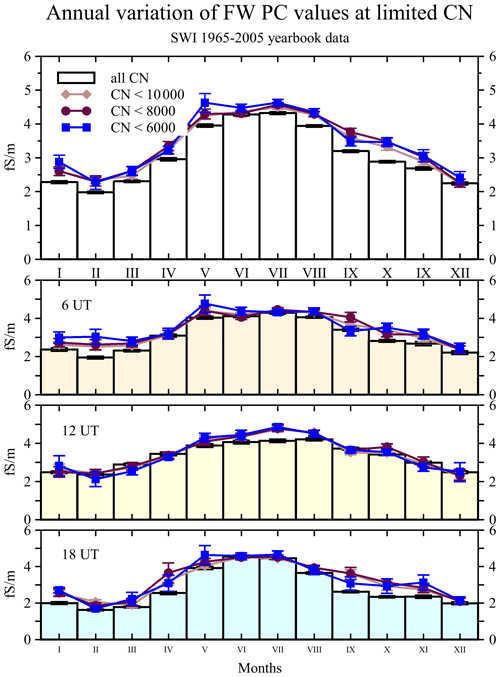
Figure 12Annual variation of air positive conductivity, PC, in fair-weather conditions for all and limited CN concentration values for all hours (upper chart) and separately for each hour (06:00, 12:00, and 18:00 UT). Error bars indicate 1 standard error.
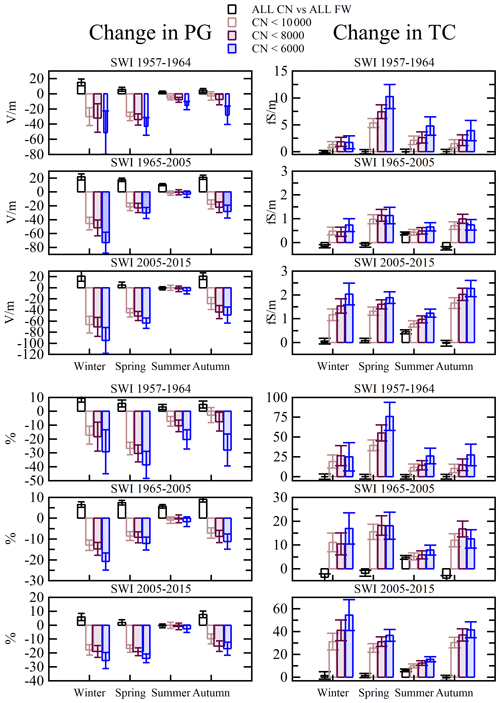
Figure 13Seasonal variations of change in the fair-weather potential gradient, PG, and total conductivity, TC, due to limited condensation nuclei, CN, concentration in the three considered periods (in 1965–2005 total conductivity equals double positive conductivity). Error bars indicate 1 standard error. Upper panels – absolute change. Bottom panels – relative change.
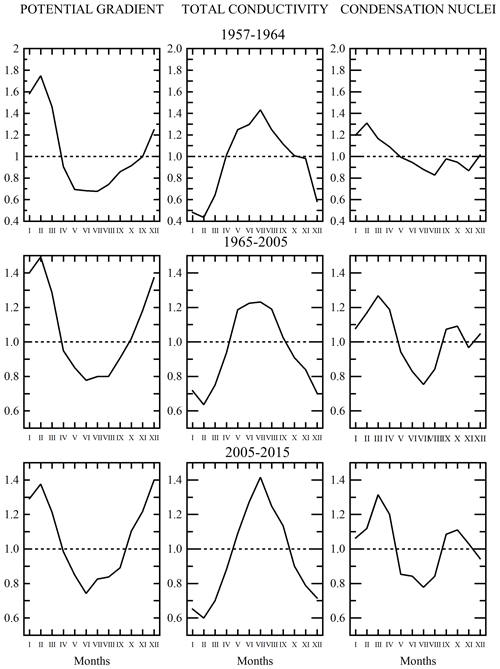
Figure 14Average annual variation of the fair-weather potential gradient, PG; total air conductivity, TC; and concentration of condensation nuclei, CN, in the three considered periods (in 1965–2005 total conductivity equals double positive conductivity).
The effect of lower CN concentrations could also be considered by season, as we discussed in Sect. 5. We extend our analysis, and in Fig. 13 we summarise the change in seasonal averages of the Świder FW PG and TC at the low CN concentration considered during the studied period and compared with other periods of 1957–1964 and 2005–2015, for which we have gathered positive and negative conductivity data. Data from 1957–1964 come from additional observatory yearbooks (see Appendix A), and data from 2005–2015 have been calculated from digital data sets collected during other project (Odzimek et al., 2018). However, up to 1964 the conductivity was only evaluated at the three terms 06:00, 12:00, and 18:00 UT, similarly to the measurement schedule for CN. In 2005–2015 there is a similar effect on the conductivity as in 1965–2005, but the period 1957–1964 differs from the later periods in an effect on PG present also during the summer. The atmospheric electricity during that era was affected in the long term by the effect of nuclear weapons tests, and due to more radioactive material present throughout the atmosphere, the effect on the electric variables could be different and spread differently by season (this requires more study). Analysis of data from 2005–2015 resembles results based on potential gradient and positive conductivity from 1965–2005. The amplitudes of absolute changes and relative changes differ between the periods, however, indicating the rather complicated nature of the relationships, probably depending mostly on the composition and types of aerosols as well as activity of ionising agents. Looking at the differences between the effects on the potential gradient and conductivity, we conclude that while there some effect of conductivity present in all seasons, the effect on summer PG is practically absent. It further confirms there are some non-ohmic contributions to PG, and therefore the annual variations of PG at such site are difficult to interpret, including any connections with annual variability of the GEC. These issues need to be further investigated.
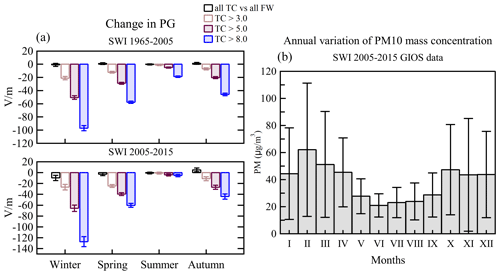
Figure 15(a) Seasonal variations of change in the potential gradient, PG, at three threshold values for the total air conductivity: 3, 5, and 8 fS m−1, respectively (in 1965–2005 total conductivity equals double positive conductivity). Error bars indicate 1 standard error. (b) Monthly averages and standard deviations of PM10 mass concentration at Świder for the years 2005–2015 (GIOŚ data). Error bars indicate 1 standard deviation.
One way of removing the effects of the mid-day convection is to consider the night-time conditions or select periods of more stable conditions. Another issue is the effect of other aerosol types like dust particles, which are not all measured by CN counters and affect the conductivity and indirectly the potential gradient, which needs to be taken into account. One may consider a similar procedure with threshold values of the conductivity and corresponding effects in the PG annual variation. This is presented in Fig. 15a, where, similarly to Fig. 13, we plotted the annual variation of PG at values of the total conductivity higher than 3.0, 5.0, and 8.0 fS m−1. The biggest effect is observed during winter, and a very small effect is observed again in the summer. This confirms that the winter pollution strongly affects the PG, which may come from the load of fractions of aerosol and dust particles, outside the range of measured condensation nuclei. In Fig. 15b we present the annual variability of PM10 mass concentrations at Świder from the period 2005–2015. The highest PM10 mass concentrations were observed in the period from October to April, with a maximum values of 62.1 and 51.2 µg m−3 noted in February and March, respectively. The average values of PM10 in October, November, December, January, and April are comparable and range between 43.5 and 47.3 µg m−3. The smallest concentrations were observed from May to September, with the lowest value (20.9 µg m−3) noted in June. The mean values of PM10 in the period of May–September (except in June) oscillated between 23.0–28.7 µg m−3. Such annual variation is characterised for other stations located in Central Poland (Pietruczuk and Jarosławski, 2013). Elevated values of PM10 registered during late autumn, during winter, and at the beginning of spring are related to more intensive domestic heating during the cold part of the year. Additionally, specific meteorological conditions observed during winter anticyclones (low wind speed and stable boundary layer) are favourable for accumulation of PM10. The enhanced emission of dust, particularly in the winter, may have a strong effect on the conductivity. On the other hand, with the levels of mass concentration of PM10 in the summer, even having a much smaller variability (lower standard deviation), we do not observe much of an effect on the PG then. Again, this may indicate a non-ohmic contribution to the PG present notably in the summer. We also need to note that the variations shown in Fig. 15a and b are difficult to compare and draw conclusions from because what is measured as PM10 is the mass concentration, and for conductivity we require number concentrations and particle size spectra.
At many land atmospheric electricity stations, including Świder, the increase in the potential gradient during local wintertime or rush hours, which is usually related to an increase in emission from intensive domestic heating and transport, is considered to be due to a decrease in the electrical conductivity (Harrison, 2006; Kubicki et al., 2016; Tacza et al., 2021). Having at disposal all digitised PG hourly values we calculated the diurnal variation of PG from all available fair-weather hours. As in the previous results of such analysis at Świder (e.g. Warzecha, 1991; Kubicki et al., 2007), made on the basis of 24 h fair-weather days for 1965–2000 or fair-weather hours during days with 12 h of FW conditions over the time period 2004–2011 (Michnowski et al., 2021), the PG diurnal variation shown in Fig. 5 confirmed the different behaviour according to season. The double oscillation is evident during spring, summer, and autumn (in the summer with peaks at 07:00 and 20:00 UT), and a single oscillation is evident in winter (a minimum at ∼ 03:00 UT and a peak at 19:00 UT). Similar PG diurnal curves were found in Reading for summer and winter (Nicoll et al., 2019). One hypothesis for the two PG peaks found in summer at urban sites could be due to pollution of vehicular traffic during rush hours. Majewski and Przewoźniczuk (2009) performed particulate matter (10 µm) measurements for 11 stations in Warsaw. They found two clear peaks (07:00 and 20:00 UT) in warm weather (April to September) and less pronounced peaks in cold weather (October to March). As mentioned earlier, Świder is located in a suburban site, so vehicular transportation is not expected to affect the PG diurnal variation too much. Then, the hypothesis for the difference in the PG diurnal variation in summer and winter is a combination of the “sunrise effect”, generally thought to be related to mixing of the near-surface electrode layer (which is an accumulation of positive charge next to Earth's negatively charged surface). The first peak (at ∼ 07:00 UT) could be associated both with the dynamic changes in the planetary boundary layer and with the generation of the secondary aerosol (Kubicki et al., 2007). Then, as the temperature is continuously increasing, the convection intensifies, producing mixing processes in the PBL and causing the transport of aerosol to higher altitudes, and therefore the PG decreases. As the temperature decreases after 16:00 UT the PG returns to normal values. In winter, the reduced variability in PBL height (due to diminished convection) therefore leads to more quiescent meteorological conditions, which results in a more stable diurnal variation in PG and the disappearance of the morning maximum peak (see also Nicoll et al., 2019).
The annual cycle of emissions with maxima in the winter and minima in the summer affecting the land PG measurements (Adlerman and Williams, 1996; Nicoll et al., 2019; Shatalina et al., 2019) is considerable at Świder, as confirmed in the analysis in Sect. 3 (Figs. 5, 6, and 8). Similar behaviour in the PG seasonal variation was found in Kew and Reading, in the UK, and Nagycenk, in Hungary (Märcz et al., 1997; Harrison and Aplin, 2002; Nicoll et al., 2019). Harrison and Aplin (2002) attributed the PG higher values during winter, at Kew, to the influence of smoke pollution. Märcz et al. (1997) suggested that the PG seasonal variation at Nagycenk is likely associated with the condensation nuclei variation. Nicoll et al. (2019) suggested that the PG higher values during winter at Reading are due to more use of domestic heating, and it is very likely that at Świder the PG values are higher during winter due to domestic heating producing soot. This is also in agreement with the simple conductivity model in this work. Measurements of PM2.5 in Krakow (south of Poland) in 2020/2021 found higher PM2.5 concentrations during winter months compared with summer months (Ryś and Samek, 2022). The time intervals of this study and the PG measurement at Świder are different (in fact both site locations are very far away); however, a similar behaviour in PM is very likely at Świder.
The aerosol concentration also changes annually due to variation in convection processes in the planetary boundary layer (PBL) and in the PBL height; these variations are more influential during the warm season and especially in the local summertime. At Świder, as discussed in Sect. 3, the summer CN concentrations differ much more from the rest of the year (Fig. 4), with them being minimal through all the year. As opposed to winter, the change in the summer concentrations does not seem to be so significant on average (Fig. 11). The effect of reduced aerosol concentration to its lowest levels did not change the average PG amplitude in the summer, while in the other seasons this effect was observed particularly in the winter (Sect. 4). However, analyses of annual variations of PM10 mass concentrations measured at Świder in 2005–2015 indicate twice as strong concentrations and high variability in the winter. It is difficult to verify quantitatively the effect it has on the air conductivity, but the analysis shown in Fig. 15 indicates some qualitative effects, especially in the winter, most possibly due to the increased load of dust.
Dust particles used to be measured at the Świder observatory, using different methods. Modern measurements are performed in collaboration with Poland's state agencies, such as the State Sanitary Inspection or Chief Inspectorate for Environmental Protection. At the beginning an Owens dust counter was used (Kalinowska, 1962). We are not aware of any digital records from this period. Using the measurements with the counter from 1957–1960 and the measured condensation nuclei concentrations, Haberka (1961)1 investigated the dependence of the amount of the dust particles compared to the concentration of CN. At concentrations higher than 10 000 cm−3, the number of dust particles in 1 cm3 was larger than 37. In the CN range 5000–10 000 cm−3 it was 27 in 1 cm3, a value relevant to dust concentration in the warm season 24–29 cm−3 (48–70 cm−3 in the cold season). This result supports the methods presented in this study; however, the relationships between aerosol, dust, air conductivity, and the atmospheric potential gradient are complicated, and the lack of thorough and continuous measurements of all relevant quantities further complicates such a study.
Table 8Mean value and standard error of air positive conductivity in fair-weather conditions (mean of 3 h: 06:00, 12:00, and 18:00 UT, and at each hour) by month for all and limited CN concentrations.

The changes in PG due to changes in the conductivity and other processes obscure the real changes in the PG resulting from the activity of the GEC at a mid-latitude land station like Świder, and the annual maximum of the PG occurs usually during local winter. In this work we wanted to investigate in what way taking into account fair-weather PG values at low CN concentrations affects the PG annual maximum. In general, our results show that, even though the PG decreases at low CN concentrations possible in the winter and in the autumn, the maximum of the PG remains in the winter, and when investigating similar effects on the conductivity they are differently dependent on season (Tables 7 and 8, Figs. 12 and 13). When looking at the annual curves of variation of the PG, total conductivity (TC), and concentrations of condensation nuclei, CN, these have differing departures from their annual mean, and these changes are caused by different factors. The changes in the annual or seasonal course of PG are not adequate to corresponding relative changes in TC or CN, and neither in PM mass concentrations (Figs. 13–15).
According to the conductivity model for varying ground-level CN concentrations characteristic of Świder, described in Sect. 5, there could be increases in the ion conductivity and decreases in the PG, but the relative change differs from the observed conditions. This requires further investigation. Analysis of conduction current density as a product of PG and conductivity may provide more insight into the annual variation; however, the effects of any non-ohmic contribution, such as due to convection, will still be difficult to remove.
The findings of this work could be summarised as follows.
-
We calculated diurnal, seasonal, and annual variations of the fair-weather potential gradient based on 1965–2005 digitised time series of data from Świder observatory yearbooks, and we provided details of the statistics for the PG and the condensation nuclei CN number concentrations, measured during this period at three specific hours of measurement (06:00, 12:00, and 18:00 UT). The general average mean of PG is 230 V m−1, and the average PG at the CN concentration observation terms is 248 V m−1, while the CN average mean is about 19 000 cm−3. The PG and CN distributions are both leptokurtic (i.e. narrow) and right-skewed. A subset of PG values for CN concentration below 10 000 cm−3 (which correspond to 20 % of the whole CN–PG pair data) was selected for further analysis of the effect of aerosol concentration on the PG variation. In particular, we aimed to investigate the PG annual variation in connection with the GEC variability. The PG average mean for reduced levels of CN concentrations is 221 V m−1, and the CN average mean in this subset is 7290 cm−3.
-
Summer and winter months have a clear signature in the PG diurnal variation for all CN concentrations, likely associated with mixing processes in the planetary boundary layer. For the subset with CN below 10 000 cm−3, we found that PG values do not show any significant variation in the summer. On the other hand, for the winter we found a PG difference of 11 %. Furthermore, this PG difference is about 20 % when we consider CN below 6000 cm−3.
-
Local winter months have higher PG values compared with local summer months – a common feature of continental atmospheric electricity stations. This PG seasonal variation is maintained even at lower CN concentrations (e.g. 8000, 6000 cm−3). We found that there is a reduction in the PG values by 11 %–26 %, with the biggest difference in February. In the summer months this difference is negligible. From this, we can conclude that aerosol at these concentrations has more of an effect in the PG during winter compared with summer.
-
In contrast, local summer months have higher positive conductivity values compared with local winter months; for Świder there is factor of 1.8 between the corresponding mean average values of 3.98 ± 0.01 × 10−15 S m−1 and 2.24 ± 0.01 × 10−15 S m−1, respectively. At lower CN concentrations (e.g. 10 000, 8000, and 6000 cm−3), we found an increase in the conductivity by 7 %–17 % over the winter, spring, and autumn and summer. This is different from the effect on the PG and also could indicate a non-ohmic PG component or a component which is not very sensitive to CN concentration levels, or both. Any future analyses of the annual variation of the PG in the hope of finding an annual variation of the GEC have to take these effects into account.
-
Analyses of additional data sets from 2005–2015 confirm the similar influence of reduced CN on PG and the conductivity. A question remains of whether any PG data from a location like Swider could be used for the investigation of the annual variation of the GEC. There are issue like the effects of the mid-day convection. Another issue is the effect of other aerosol types like dust particles, which may not all be measured by CN counters. They affect the conductivity and indirectly the potential gradient, which needs to be taken into account. These methods require continuous or more frequent monitoring of aerosols. Analysis of the annual variation of the conduction current is another possibility to investigate these variations; however, the difficulties in removing the effects of any non-ohmic contribution such as this due to convection will still be difficult to overcome. Simultaneous measurements of Maxwell current density may also be required in such case (Odzimek et al., 2018).
-
A simplified modelling of electrical conductivity affecting the PG is created. The ion loss in this model is due to attachment mainly to water-soluble aerosol particles and soot particles, the main components of continental aerosol. A more realistic model should include the effects on conductivity of dust or soot of particle sizes larger than the CN.
This Appendix contains additional Tables: Table A1, Table A2, and Table A3.
Table A1Number of hourly values of PG at fair-weather hours divided into months for January 1965–December 2005. The last column indicates the number of hours without PG measurements.
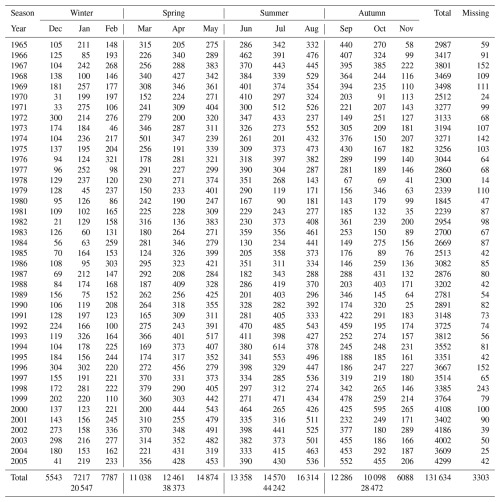
Table A2Number of fair-weather days (24 h) divided into months for the period of January 1965–December 2005.
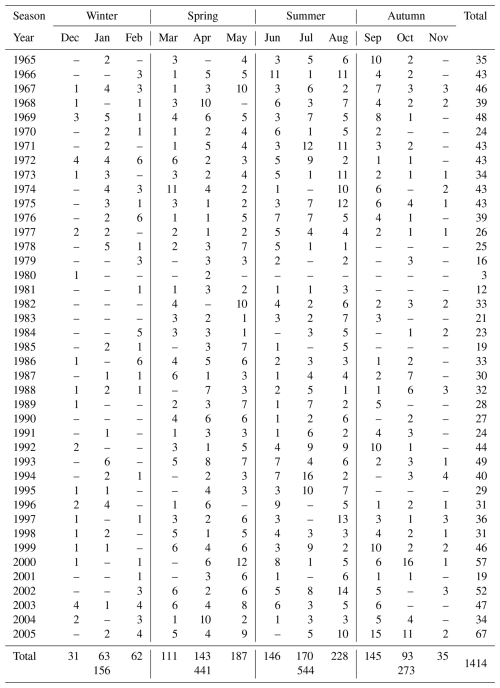
Świder atmospheric electricity and condensation nuclei data are available on request from co-author Anna Odzimek (aodzimek@igf.edu.pl) and are published at https://doi.org/10.25171/InstGeoph_PAS_IGData_supporting-data-for-doi-10-5194-angeo-2024-1 (Odzimek and Pawlak, 2025). Świder PM10 data for 2005–2015 were downloaded from the data archives of the Chief Inspectorate for Environmental Protection, Poland, https://powietrze.gios.gov.pl/pjp/archives (GIOŚ, 2025).
The Supplement contains the list of Świder observatory yearbooks used in the study. The supplement related to this article is available online at https://doi.org/10.5194/angeo-43-391-2025-supplement.
AO digitised PG and CN data from Świder yearbooks and conceived the subject of the study. IZ and AO performed the investigation and wrote and revised the paper. DK and JT revised and edited the paper. All authors discussed the results.
The contact author has declared that none of the authors has any competing interests.
Publisher's note: Copernicus Publications remains neutral with regard to jurisdictional claims made in the text, published maps, institutional affiliations, or any other geographical representation in this paper. While Copernicus Publications makes every effort to include appropriate place names, the final responsibility lies with the authors.
This research has been supported by the Narodowe Centrum Nauki (grant no. 2021/41/B/ST10/04448).
This paper was edited by Petr Pisoft and reviewed by Earle Williams and one anonymous referee.
Adlerman, E. J. and Williams, E. R.: Seasonal variation of the global electrical circuit, J. Geophys. Res.-Atmos., 101, 29679–29688, https://doi.org/10.1029/96JD01547, 1996. a, b, c
Bennett, A. J. and Harrison, R. G.: Variability in surface atmospheric electric field measurements, J. Phys. Conf. Ser., 142, 012046, https://doi.org/10.1088/1742-6596/142/1/012046, 2008. a
Burns, G. B., Frank-Kamenetsky, A. V., Tinsley, B. A., French, W. J. R., Grigioni, P., Camporeale, G., and Bering, E. A.: Atmospheric Global Circuit Variations from Vostok and Concordia Electric Field Measurements, J. Atmos. Sci., 74, 783–800, https://doi.org/10.1175/JAS-D-16-0159.1, 2017. a
Christian, H. J., Blakeslee, R. J., Boccippio, D. J., Boeck, W. L., Buechler, D. E., Driscoll, K. T., Goodman, S. J., Hall, J. M., Koshak, W. J., Mach, D. M., and Steward, D. F.: Global frequency and distribution of lightning as observed from space by the Optical Transient Detector, J. Geophys. Res.-Atmos., 108, ACL 4-1–ACL 4-15, https://doi.org/10.1029/2002JD002347, 2003. a
GIOŚ: Hourly averaged PM10 data, 2005–2015, station: Otwock, ul. Brzozowa 2, Bank danych pomiarowych, Główny Inspektorat Ochrony Środowiska (Chief Inspectorate for Environmental Protection), https://powietrze.gios.gov.pl/pjp/archives, last access: 15 March 2025. a
Grabovskiy, R. I.: Atmosfernye jadra kondensacii, Gidrometeoizdat, Leningrad, 164 pp., 1956. a, b, c
Haberka, Z.: Zapylenie powietrza w Świdrze, Travaux de l’Observatoire Géophysique de St. Kalinowski à Świder, 20, 54–60, 1961. a
Harrison, R.: Urban smoke concentrations at Kew, London, 1898–2004, Atmos. Environ., 40, 3327–3332, https://doi.org/10.1016/j.atmosenv.2006.01.042, 2006. a
Harrison, R. and Aplin, K.: Mid-nineteenth century smoke concentrations near London, Atmos. Environ., 36, 4037–4043, https://doi.org/10.1016/S1352-2310(02)00334-5, 2002. a, b
Harrison, R. G.: The Carnegie Curve, Surv. Geophys., 34, 209–232, https://doi.org/10.1007/s10712-012-9210-2, 2013. a
Hess, M., Koepke, P., and Schult, I.: Optical Properties of Aerosols and Clouds: The Software Package OPAC, B. Am. Meteorol. Soc., 79, 831–844, https://doi.org/10.1175/1520-0477(1998)079<0831:OPOAAC>2.0.CO;2, 1998. a
Hoffmann, K.: Bericht uber die in Ebeltofthafen auf Spitsbergen in der Jahren 1913/14 durchgefurten luftelektrischen Messungen (11 36′ 15′′ E, 79 09′ 14′′ N), Beitr. Phys. Frei. Atmos., 11, 1–19, Report the Atmospheric Electric Measurements Performed in 1913/14 in Ebeltolthafen in Spitsberegen (11 36′ 15′′ E, 79 09′ 14′′ N), 1924. a
Imyanitov, I. M. and Chubarina, Y. V.: Electricity of free atmosphere, Gidrometeoizdat, Leningrad, 1965, Technical Translation from Russian, NASA, Washington, TT F-425, https://archive.org/details/nasa_techdoc_19680000611 (last access: 8 July 2025), 1967. a
Israël, H.: Atmospheric Electricity, vol. I, Fundamentals, Conductivity, Ions, Israel Program for Scientific Translations, Jerusalem, ISBN 978-0706505177, 1973a. a, b, c, d, e, f
Israël, H.: Atmospheric Electricity, vol. II, Fields, Charges, Currents, Israel Program for Scientific Translations, Jerusalem, ISBN 978-0706511291, 1973b. a
Junge, C.: Nuclei of Atmospheric Condensation, in: Compendium of Meteorology, edited by: Byers, H. R., American Meteorological Society, 182–191, ISBN 978-1-940033-70-9, https://doi.org/10.1007/978-1-940033-70-9_15, 1951. a
Kalinowska, Z.: Historia powstania i działalności Obserwatorium Geofizycznego w Świdrze w latach 1910–1960, Ksiȩga Jubileuszowa 1910–1960, Prace Obs. Geof. Świder, 23, 54–60, 1962. a
Kalinowski, S.: Uber die Registrierung des zeitlichen Ganges des luftelektrischen Potentials in Świder, Acta Phys. Pol., 1, 499–502, 1932. a
Karasiński, G. and Kubicki, M.: Aerosol number concentration during Hornsund-Gdynia cruise in September 2013, V1, IG PAS Data Portal [data set], https://doi.org/10.25171/InstGeoph_PAS_IGData_Aerosol_ number_concentration_during_Hornsund_Gdynia_cruise_in_ September_2013, 2024. a
Kępski, D.: Aerosol concentration in vertical profile (0.02–1 µm), Hornsund, spring 2021, V1, IG PAS Data Portal [data set], https://doi.org/10.25171/InstGeoph_PAS_IGData_AVSEEFI _2021_011, 2021.
Kubicki, M.: Results of Atmospheric Electricity and Meteorological Observations at S. Kalinowski Geophysical Observatory at Świder, 2005, Publ. Inst. Geophys. Pol. Acad. Sci., D-71, 3–27, ISBN 83-88765-63-9, 2006. a, b, c
Kubicki, M., Michnowski, S., Myslek-Laurikainen, B., and Warzecha, S.: Long term variations of some atmospheric electricity, aerosol, and extraterrestrial parameters at Swider Observatory, Poland, in: Proceedings of the 12th International Conference on Atmospheric Electricity, Versailles, France, 9–13 June 2003, Vol. 1, 291–294, ISBN 2-7257-0008-6, 2003. a
Kubicki, M., Michnowski, S., and Myslek-Laurikainen, B.: Seasonal and daily variations of atmospheric electricity parameters registered at the Geophysical Observatory at Świder (Poland) during 1965–2000, in: Proceedings of the 13th International Conference on Atmospheric Electricity, Beijing, China, 13–17 August 2007, International Commission on Atmospheric Electricity, vol. I, 50–53., 2007. a, b, c, d
Kubicki, M., Odzimek, A., and Neska, M.: Relationship of ground-level aerosol concentration and atmospheric electric field at three observation sites in the Arctic, Antarctic and Europe, Atmos. Res., 178–179, 329–346, https://doi.org/10.1016/j.atmosres.2016.03.029, 2016. a, b, c, d, e, f
Kulkarni, N. M.: Non-conventional approach to computation of the atmospheric global electric parameters: Resultant data and analysis, J. Earth Syst. Sci., 131, 247, https://doi.org/10.1007/s12040-022-01981-3, 2022. a
Landsberg, H.: Atmospheric Condensation Nuclei, Beitr. Geophys., Supp. 3, 155–252, 1938. a, b
Majewski, G. and Przewoźniczuk, W.: Study of Particulate Matter Pollution in Warsaw Area, Pol. J. Environ Stud., 18, 293–300, https://www.pjoes.com/Study-of-Particulate-Matter-Pollution-r-nin-Warsaw-Area,88234,0,2.html (last access: 16 February 2024), 2009. a, b
Makino, M. and Ogawa, T.: Quantitative estimation of global circuit, J. Geophys. Res., 90, 5961–5966, https://doi.org/10.1029/JD090iD04p05961, 1985. a, b
Mani, A. and Huddar, B.: Studies of surface aerosols and their effects on atmospheric electric parameters, Pure Appl. Geophys., 100, 154–166, https://doi.org/10.1007/BF00880236, 1972. a
Märcz, F., Sátori, G., and Zieger, B.: Variations in Schumann resonances and their relation to atmospheric electric parameters at Nagycenk station, Ann. Geophys., 15, 1604–1614, https://doi.org/10.1007/s00585-997-1604-y, 1997. a, b
Matthews, J., Wright, M., Clarke, D., Morley, E., Silva, H., Bennett, A., Robert, D., and Shallcross, D.: Urban and rural measurements of atmospheric potential gradient, J. Electrostat., 97, 42–50, https://doi.org/10.1016/j.elstat.2018.11.006, 2019. a
McMurry, P. H.: The History of Condensation Nucleus Counters, Aerosol Sci. Tech., 33, 297–322, https://doi.org/10.1080/02786820050121512, 2000. a
Michnowski, S., Odzimek, A., Kleimenova, N. G., Kozyreva, O. V., Kubicki, M., Klos, Z., Israelsson, S., and Nikiforova, N. N.: Review of Relationships Between Solar Wind and Ground-Level Atmospheric Electricity: Case Studies from Hornsund, Spitsbergen, and Swider, Poland, Surv. Geophys., 42, 757–801, https://doi.org/10.1007/s10712-021-09639-3, 2021. a, b, c, d
Miller, S. and Bodhaine, B.: Supersaturation and expansion ratios in condensation nuclei counters: an historical perspective, J. Aerosol Sci., 13, 481–490, https://doi.org/10.1016/0021-8502(82)90014-3, 1982. a
Mohnen, V. and Hidy, G. M.: Measurements of Atmospheric Nanoparticles (1875–1980), B. Am. Meteorol. Soc., 91, 1525–1540, https://doi.org/10.1175/2010BAMS2929.1, 2010. a
Nicoll, K., Harrison, R., Barta, V., Bor, J., Brugge, R., Chillingarian, A., Chum, J., Georgoulias, A., Guha, A., Kourtidis, K., Kubicki, M., Mareev, E., Matthews, J., Mkrtchyan, H., Odzimek, A., Raulin, J.-P., Robert, D., Silva, H., Tacza, J., Yair, Y., and Yaniv, R.: A global atmospheric electricity monitoring network for climate and geophysical research, J. Atmos. Sol.-Terr. Phy., 184, 18–29, https://doi.org/10.1016/j.jastp.2019.01.003, 2019. a, b, c, d, e, f, g
Odzimek, A. and Pawlak, I.: Supporting data for: Diurnal, seasonal and annual variations of fair weather atmospheric potential gradient, and effects of reduced number concentration of condensation nuclei on PG and air conductivity from long term atmospheric electricity measurements at Swider, Poland, IG PAS Data Portal [data set], https://doi.org/10.25171/InstGeoph_PAS_IGData_supporting-data-for-doi-10-5194-angeo-2024-1, 2025. a
Odzimek, A., Baranski, P., Kubicki, M., and Jasinkiewicz, D.: Electrical signatures of Nimbostratus and Stratus clouds in ground-level vertical atmospheric electric field and current density at mid-latitude station Swider, Poland, Atmos. Res., 209, 188–203, https://doi.org/10.1016/j.atmosres.2018.03.018, 2018. a, b
Parkinson, W. L. and Torreson, O. W.: The diurnal variation of the electric potential of the atmosphere over the oceans, Union Terr. Magn. Electr. Bull., 8, 340–341, 1931. a
Pietruczuk, A. and Jarosławski, J.: Analysis of particulate matter concentrations in Mazovia region, Central Poland, based on 2007–2010 data, Acta Geophys., 61, 445–462, https://doi.org/10.2478/s11600-012-0069-x, 2013. a, b
Podzimek, J., J. C., C., and Yue, P.: Comparison of several Aitken nuclei counters, Atmos. Environ., 16, 1–11, https://doi.org/10.1016/0004-6981(82)90309-2, 1982. a
Rycroft, M. J., Israelsson, S., and Price, C.: The global atmospheric electric circuit, solar activity and climate change, J. Atmos. Sol.-Terr. Phy., 62, 1563–1576, https://doi.org/10.1016/S1364-6826(00)00112-7, 2000. a
Ryś, A. and Samek, L.: Yearly Variations of Equivalent Black Carbon Concentrations Observed in Krakow, Poland, Atmosphere, 13, 539, https://doi.org/10.3390/atmos13040539, 2022. a
Sapkota, B. K. and Varshneya, N. C.: On the global atmospheric electric circuit, J. Atmos. Terr. Phys., 52, 1–22, https://doi.org/10.1016/0021-9169(90)90110-9, 1990. a, b, c
Schonland, B. F. J.: Atmospheric electricity, Methuen and Co., London, second edn., ISBN 978-0598572783, 1953. a, b
Shatalina, M. V., Mareev, E. A., Klimenko, V. V., Kuterin, F. A., and Nicoll, K. A.: Experimental Study of Diurnal and Seasonal Variations in the Atmospheric Electric Field, Radiophys. Quantum. El., 62, 183–191, https://doi.org/10.1007/s11141-019-09966-x, 2019. a
Swider, W.: Ionic mobility, mean mass, and conductivity in the middle atmosphere from near ground level to 70 km, Radio Sci., 23, 389–399, https://doi.org/10.1029/RS023i003p00389, 1988. a
Tacza, J., Raulin, J.-P., Macotela, E., Marun, A., Fernandez, G., Bertoni, F., Lima, L., Samanes, J., Buleje, Y., Correia, E., Alves, G., and Makita, K.: Local and global effects on the diurnal variation of the atmospheric electric field in South America by comparison with the Carnegie curve, Atmos. Res., 240, 104938, https://doi.org/10.1016/j.atmosres.2020.104938, 2020. a
Tacza, J., Raulin, J. P., Morales, C. A., Macotela, E., Marun, A., and Fernandez, G.: Analysis of long-term potential gradient variations measured in the Argentinian Andes, Atmos. Res., 248, 105200, https://doi.org/10.1016/j.atmosres.2020.105200, 2021. a
Tinsley, B. A. and Zhou, L.: Initial results of a global circuit model with variable stratospheric and tropospheric aerosols, J. Geophys. Res.-Atmos., 111, D16205, https://doi.org/10.1029/2005JD006988, 2006. a, b, c
Warzecha, S. (Ed.): Annuaire Meteorologique et de l'electricite atmospherique 1957, Travaux de l'Observatoire Géophysique de St. Kalinowski à Świder, Państwowe Wydawnictwo Naukowe, 16, 55 pp., 1960. a, b
Warzecha, S. (Ed.): Annuaire Meteorologique et de l'electricite atmospherique 1965, Travaux de l'Observatoire Géophysique de St. Kalinowski à Świder, Państwowe Wydawnictwo Naukowe, 38, 69 pp., 1968. a, b, c
Warzecha, S.: Wpływ czynników meteorologicznych na koncentracjȩ atmosferycznych jąder kondensacji w Świdrze, PhD thesis, Institute of Geophysics Polish Academy of Sciences, 150 pp., 1974. a
Warzecha, S.: Periodical variations of the condensation nuclei content at Świder, Publs. Inst. Geophys. Pol. Acad. Sci., 99, 17–35, 1976. a, b, c, d, e
Warzecha, S.: Variations of the Electric Field and air conductivity at Swider in the years 1958–1985, Publs. Inst. Geophys. Pol. Acad. Sci., 238, 193 pp., 1991. a
Warzecha, S. and Warzechowa, K.: Wyniki pomiarów stȩżenia atmosferycznych jąder kondensacji w przybrzeżnej strefie morza w Lubiatowie, Archive of the Institute of Geophysics Polish Academy of Sciences, Institute of Geophysics Polish Academy of Sciences, 37 pp., 1979. a
Williams, E. R.: The global electrical circuit: A review, Atmos. Res., 91, 140–152, https://doi.org/10.1016/j.atmosres.2008.05.018, 2009. a
Wilson, C.: Condensation of Water Vapour in the Presence of Dust-Free Air and Other Gases, Philos. T. R. Soc. Lond., 189, 265–307, 1897. a
Witkowski, A.: Note sur l'électricité atmosphérique à Zakopane dans les Tatras (Polish title: Spostrzeżenia nad elektrycznością atmosferyczną w Zakopanem), Bull. Acad. Sci. Cracovie A, 42, 7–10, 1902. a
Wright, M., Matthews, J., Silva, H., Bacak, A., Percival, C., and Shallcross, D.: The relationship between aerosol concentration and atmospheric potential gradient in urban environments, Sci. Total Environ., 716, 134959, https://doi.org/10.1016/j.scitotenv.2019.134959, 2020. a
The correct surname is most likely Haberko.
- Abstract
- Introduction
- Świder published atmospheric electricity data sets
- Overview of fair-weather PG, PC, and CN data
- Diurnal and seasonal variation of the potential gradient in Świder, 1965–2005
- Diurnal, seasonal, and annual variation at different levels of CN concentration
- PG and conductivity model with variable aerosol content
- Effect of low CN concentrations on the air positive conductivity
- Discussion
- Summary
- Appendix A
- Data availability
- Author contributions
- Competing interests
- Disclaimer
- Financial support
- Review statement
- References
- Supplement
- Abstract
- Introduction
- Świder published atmospheric electricity data sets
- Overview of fair-weather PG, PC, and CN data
- Diurnal and seasonal variation of the potential gradient in Świder, 1965–2005
- Diurnal, seasonal, and annual variation at different levels of CN concentration
- PG and conductivity model with variable aerosol content
- Effect of low CN concentrations on the air positive conductivity
- Discussion
- Summary
- Appendix A
- Data availability
- Author contributions
- Competing interests
- Disclaimer
- Financial support
- Review statement
- References
- Supplement





